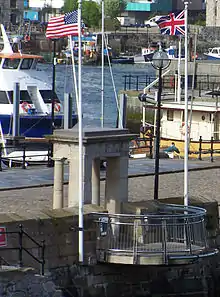Mayflower Steps
The Mayflower Steps are close to the site in the Barbican area of Plymouth, south-west England, from which the Pilgrim Fathers are believed to have finally left England aboard the Mayflower on 6 September 1620, before crossing the Atlantic Ocean to settle in North America. The traditional site of their disembarkation in North America is Plymouth Rock.

The passengers who came predominantly from East Anglia sought religious and other freedoms. They had no links with Plymouth, but because of bad weather in the English Channel they were forced to put in at Plymouth seeking shelter and essential repairs. Several surviving local buildings including what is now the Plymouth Gin Distillery in Southside Street and the Island House on the Quay are claimed to have accommodated some of them for one or more nights.
The 'Steps' today consist of a commemorative portico with Doric columns of Portland stone that was built in 1934,[1] and a small platform over the water with a brushed steel rail and a shelf with some nautical bronze artwork and historical information. It is on a small pier that was built about a century ago or possibly in 18th century no one is definitely sure, when some very old houses that were blocking construction of a road around the seaward side of the Citadel leading to the Hoe were cleared together with the significant Watch House. Today, boat trips leave the Mayflower Steps for trips around the Sound and up the Tamar for sight of the 'Dockyard and Warships'.
The best effort by local historians to place the actual site of the Mayflower finally casting off is roughly where a Victorian public house, the Admiral MacBride, now stands.
References
- Brian Moseley (2003). "Mayflower Memorial". Retrieved 2007-11-28.Moseley, Brian (July 2009) [2003]. "Mayflower Memorial". The Encyclopaedia of Plymouth History. Plymouth Data. Archived from the original on 13 September 2010. Retrieved 15 February 2015.
